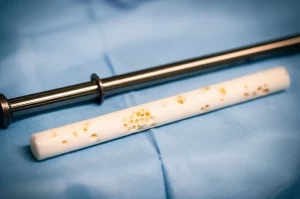Beyond the Knife: Tracking Esophageal Cancer with DNA and Immunotherapy
Hey there! Let’s talk about something pretty important: esophageal cancer, specifically the squamous cell kind (OSCC). It’s a tough one, and sadly, it’s a really big deal globally, especially in places like East Asia. For years, the go-to move for locally advanced, but still treatable, OSCC has been hitting it with chemo and radiation before surgery. It definitely beats just doing surgery alone, which is great, but we’ve seen in some big trials that just adding radiation doesn’t always translate into *longer* overall survival, even if it shrinks the tumor locally. This got folks thinking: maybe we need to amp up the *systemic* treatment – the stuff that works throughout the whole body – to really make a difference long-term.
Enter immunotherapy! This is the cool new kid on the block that’s been shaking things up in cancer treatment. These drugs, like immune checkpoint inhibitors, basically take the brakes off your own immune system so it can fight the cancer better. They’ve shown some real promise in more advanced esophageal cancer cases. So, the logical next step? Let’s see what happens when we mix immunotherapy with the standard neoadjuvant chemotherapy (that’s the chemo given *before* surgery). We’ve seen this combo work wonders in other cancers, like certain lung cancers, boosting response rates and survival.
Diving into the Study
So, that’s exactly what this study, a phase 2 trial, set out to do. We wanted to see if adding nivolumab, a type of immunotherapy, to chemotherapy *before* and *after* surgery could be a good and safe option for these locally advanced OSCC patients. And here’s the really neat part: we also decided to keep a close eye on something called circulating tumor DNA, or ctDNA. Think of ctDNA as tiny fragments of cancer DNA floating around in your blood. Monitoring this could potentially give us a heads-up on how well the treatment is working and maybe even predict who’s more likely to have the cancer come back.
The setup was pretty straightforward, but rigorous. We had patients from five different hospitals, and they were randomly put into one of two groups. Two out of three patients went into the group that got nivolumab plus standard chemo (cisplatin and paclitaxel) before surgery. The other third got a placebo (a dummy drug) along with the same chemo. Everyone who could, then had surgery. If the surgery didn’t show a complete wipeout of the cancer (what we call a pathological complete response, or pCR), those patients then got adjuvant nivolumab (that’s immunotherapy *after* surgery).
Our main goal was to see if the nivolumab group had a significantly higher pCR rate. We also looked at other important things like how many patients had a complete surgical removal (R0 resection), how long patients lived without the cancer coming back or getting worse (event-free survival, EFS), and overall survival (OS). Safety was, of course, a top priority too.
The Initial Findings: A Bit of a Mixed Bag?
Alright, let’s get to the results. We enrolled 90 patients in total. When we looked at the primary goal – the pCR rate – things weren’t dramatically different between the groups. The nivolumab group had a pCR rate of 15%, while the chemo-only group was right there at 13.3%. Statistically speaking, that wasn’t a significant difference. The rate of getting a clean surgical margin (R0 resection) was also super high and pretty much the same in both groups (over 96%).
And when we looked at survival after about two years of follow-up? Again, no big statistical difference popped out between the two groups for EFS or OS. The numbers looked slightly better for the nivolumab group (63.11% EFS vs. 60.47%, and 83.32% OS vs. 79.4%), but not enough to call it a clear win based on this study’s size and duration.
Now, you might be thinking, “Okay, so the combo didn’t really move the needle on pCR or survival in this study?” And based purely on those main endpoints, you’d be right. But this is where the ctDNA part gets really interesting and potentially changes how we think about monitoring these patients.

The ctDNA Story: A Glimpse into the Future?
Remember that circulating tumor DNA we talked about? This is where the nivolumab combination really seemed to shine. At the start of the study, *every single patient* had detectable ctDNA. But after the neoadjuvant treatment, a whopping 89% of patients in the nivolumab group had their ctDNA turn negative, compared to 62.5% in the chemo-only group. That’s a significant difference! It suggests that even if the nivolumab didn’t boost the *pathological* response rate significantly in the tumor itself, it was doing something powerful systemically, clearing out those tiny bits of cancer DNA floating around.
And here’s the kicker: when we looked at how patients did over time based on their ctDNA status, especially *after* treatment and surgery, we saw a really strong link. Patients who had detectable ctDNA before surgery had significantly worse disease-free survival (DFS – how long they lived without the cancer coming back). This held true even after accounting for other factors. It was like the ctDNA was a better predictor of who was going to relapse than just looking at how much the main tumor shrank under the microscope.
This signal got even stronger when we looked at ctDNA levels after surgery (what we called the “landmark” timepoint). If ctDNA was still detectable then, patients had significantly poorer DFS and OS. This landmark ctDNA status turned out to be a really precise predictor of who would have their cancer return.
Tracking Over Time
But wait, there’s more! We also tracked ctDNA levels over time during follow-up. This longitudinal monitoring gave us a dynamic picture. Patients whose ctDNA remained negative throughout, or who cleared it and stayed negative, had the best outcomes by far. If ctDNA popped up or stayed positive, it was a strong sign that the cancer was likely coming back, and often sooner rather than later. This suggests that tracking ctDNA isn’t just a one-time check; it could be a powerful tool for ongoing surveillance and potentially for seeing if adjuvant therapy (the treatment after surgery) is actually working to keep minimal residual disease in check.
Think about it: if a patient gets adjuvant immunotherapy after surgery because they didn’t have a complete response, and their ctDNA stays positive or turns positive, maybe that tells us that particular therapy isn’t doing the job, and we need to think about something else. On the flip side, if their ctDNA clears and stays clear, that’s a great sign!

What Does This All Mean?
So, what’s the takeaway from all this? First off, adding perioperative nivolumab to chemotherapy for locally advanced OSCC seems feasible and safe. While it didn’t significantly boost the pCR rate or survival outcomes compared to chemo alone in this specific study, it *did* significantly improve the clearance of circulating tumor DNA. This ctDNA clearance is a really intriguing finding because the study also showed that ctDNA status, particularly after treatment and surgery, is a strong predictor of who will stay cancer-free and who will relapse.
This suggests that ctDNA monitoring isn’t just a cool scientific tool; it has real potential to become a valuable part of how we manage these patients. It could help us identify who is at high risk of recurrence even after successful surgery and guide decisions about whether and how to continue treatment after surgery. It might be a way to see the systemic effect of treatment, even if the local tumor response isn’t a complete pCR.
Of course, this is a phase 2 study, and there are limitations. We need longer follow-up to see if those trends in survival eventually become statistically significant. The COVID-19 pandemic made collecting some samples tricky. And we definitely need larger, phase 3 trials to confirm these ctDNA findings and really nail down how best to use this information in the clinic. We also need to understand *why* immunotherapy seems so good at clearing ctDNA, even when it doesn’t always lead to a pCR.
But all in all, this study gives us a lot to be excited about. It reinforces that perioperative immunotherapy plus chemo is a viable option and highlights the incredible potential of using ctDNA monitoring to get a deeper understanding of how patients are responding systemically and to better predict their future. It feels like we’re getting closer to using these tiny DNA fragments to guide big treatment decisions!

Source: Springer







